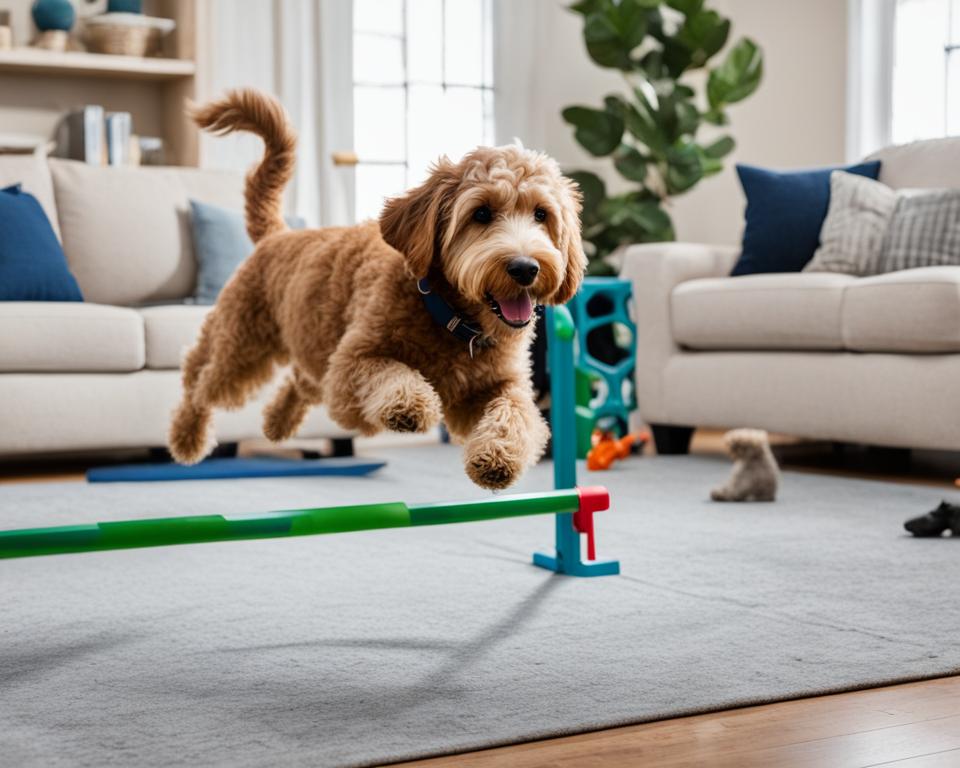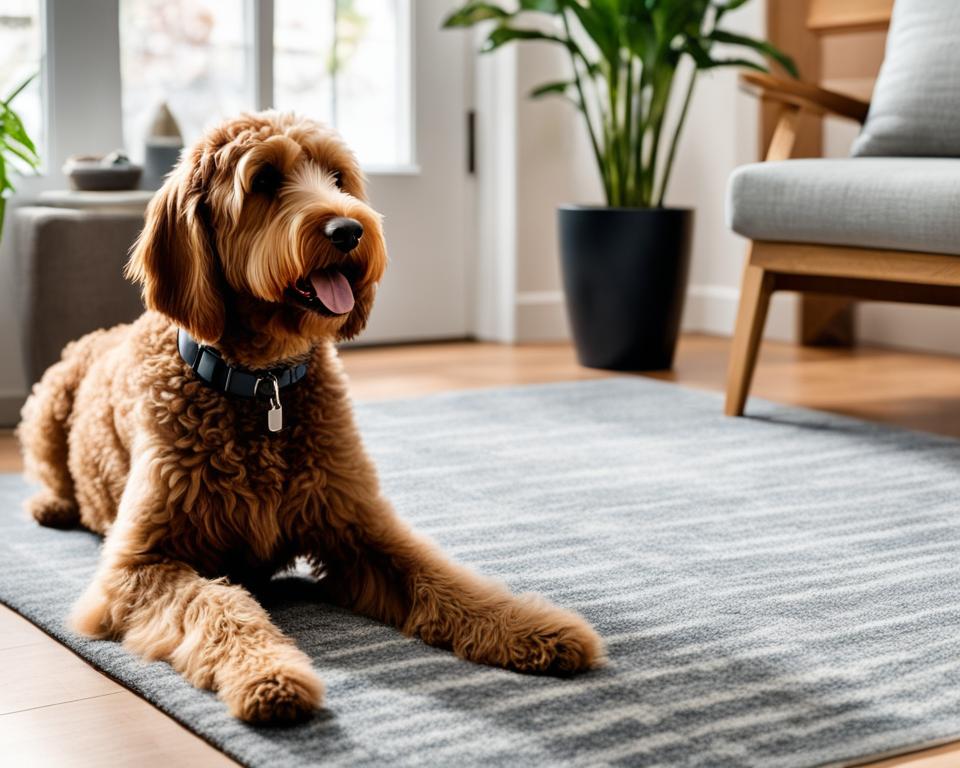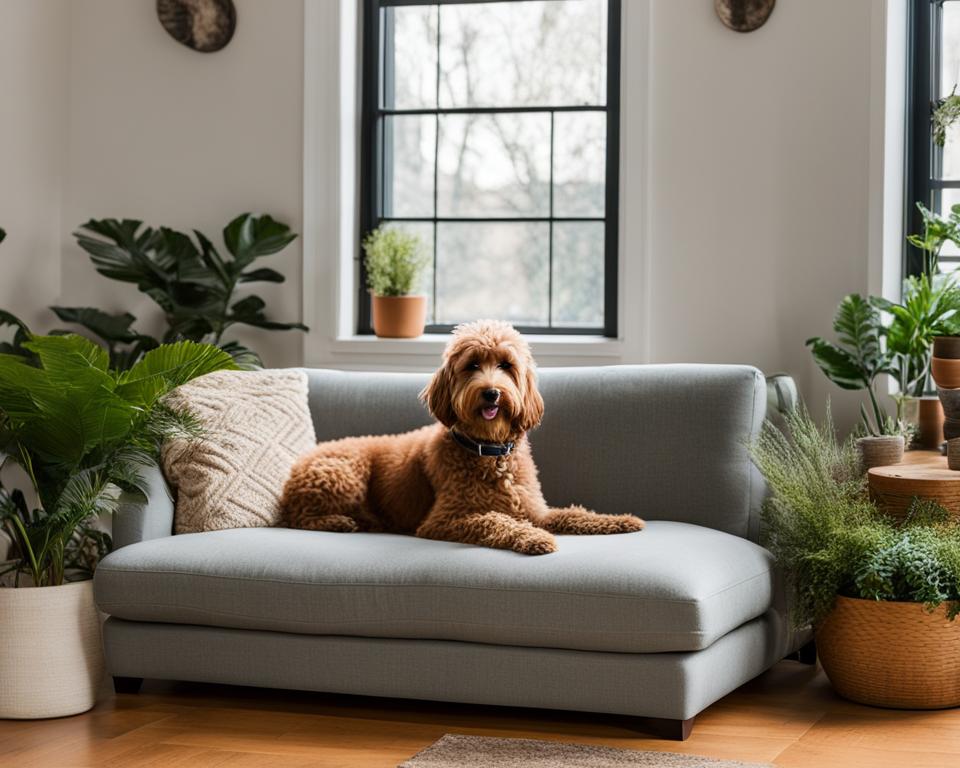Labradoodles are social dogs that thrive on human contact and companionship. To create an ideal indoor environment for Labradoodles, it is important to focus on sleep, house training, socialization, and creating a designated puppy space. Consistency, patience, and a calm environment are key in helping Labradoodles transition smoothly into their new homes.
Key Takeaways:
- Labradoodles are social dogs that require human contact and companionship.
- Create a designated puppy space inside the house to provide a sense of security.
- Consistency, patience, and a calm environment are essential for Labradoodle’s well-being.
- Focus on sleep, house training, and socialization to create an ideal indoor environment.
- Gradually introduce Labradoodles to larger spaces in the house over time.
Labradoodle Training Indoors
Training Labradoodles indoors is crucial for instilling good behavior and ensuring a happy coexistence. By teaching them basic commands like sit, stay, come, and leave it, you establish a foundation for their obedience and responsiveness. Utilizing positive reinforcement techniques, such as treats and praise, during training sessions fosters a positive learning experience and encourages them to repeat desirable behaviors.
Labradoodles thrive on human interaction and companionship, so it’s important to spend quality time with them indoors. Engage in interactive play and provide mental stimulation through activities like puzzle toys and obedience training. By doing so, you can prevent boredom, redirect their energy towards positive outlets, and discourage destructive behavior.
Establishing a consistent routine is key to successful training. Setting aside specific times for training sessions and adhering to a structured schedule helps your Labradoodle understand expectations and boundaries. Consistency strengthens their understanding of what is acceptable behavior indoors.
Mental Stimulation and Interactive Play
Engaging your Labradoodle’s mind is as essential as physical exercise. Puzzle toys and games can provide mental stimulation and challenge their problem-solving abilities. Additionally, obedience training sessions that introduce new commands and tricks can keep their minds sharp and engaged.
Interactive play is another effective way to prevent restlessness and alleviate indoor boredom. Incorporate games like fetch, interactive hide-and-seek, or scent work that tap into their natural instincts. By regularly engaging in these activities, you can keep your Labradoodle mentally and physically stimulated, leading to a fulfilled and well-behaved companion.
| Training Tips for Labradoodles Indoors | Benefits |
|---|---|
| Teach basic commands (sit, stay, come, leave it) | Establishes obedience and responsiveness |
| Utilize positive reinforcement techniques | Fosters a positive learning experience |
| Engage in interactive play and provide mental stimulation | Prevents boredom and destructive behavior |
| Establish a consistent training routine | Strengthens understanding of acceptable behavior indoors |
Training Labradoodles indoors not only ensures a well-behaved pet but also strengthens the bond between you and your furry friend. By dedicating time to their training and mental stimulation, you create a harmonious environment where your Labradoodle can thrive. With patience, consistency, and positive reinforcement, you’ll raise a happy and obedient companion.
Exercise and Entertainment for Labradoodles Indoors
Providing indoor exercise and entertainment for Labradoodles is crucial, especially in situations when outdoor activities are limited due to inclement weather or living arrangements in apartments or houses without a backyard. There are various labradoodle-friendly indoor activities that can help keep your furry companion engaged, physically active, and mentally stimulated.
1. Interactive Games and Toys
Labradoodles enjoy interactive games that challenge their problem-solving skills and provide mental stimulation. Hide and seek is a popular game where you can hide treats or toys around the house and encourage your Labradoodle to find them. Scent work is another engaging activity that taps into their excellent sense of smell. You can hide treats or use specific scent-detection toys for your Labradoodle to search and find. Puzzle toys, treat-dispensing toys, and interactive feeding toys are also great options to keep them entertained while providing a stimulating activity.
2. Indoor Exercise Options
There are several ways to ensure your Labradoodle gets enough exercise indoors. Playing fetch with soft balls or toys that are safe for indoor use can help them burn off energy and keep them physically active. If you have a treadmill, you can introduce your Labradoodle to walking or jogging on it. Gradually increase the speed and duration as they become comfortable. Another option is setting up an indoor agility course using common household items like chairs or cones. This allows your Labradoodle to practice jumps and learn new agility exercises while having fun indoors.
3. Training Sessions and Tricks
Engaging in training sessions and teaching your Labradoodle new tricks is a fantastic way to keep them mentally stimulated and entertained indoors. Training not only strengthens your bond but also provides mental exercise. Teach them commands like sit, stay, paw, or roll over using positive reinforcement techniques such as treats and praise. You can also introduce more advanced tricks like playing dead or retrieving specific objects. Labradoodles thrive on human interaction, and training sessions give them an opportunity for mental growth while also keeping them engaged indoors.

Indoor Potty Training for Labradoodles
Indoor potty training is an essential part of creating a comfortable living environment for your Labradoodle. By following a consistent training schedule and establishing a designated potty area, you can effectively teach your dog where to eliminate indoors.
Creating a Designated Potty Station
To begin indoor potty training, it is crucial to create a designated potty station for your Labradoodle. This area should be easily accessible and located away from your dog’s sleeping and eating areas. There are several options for potty stations:
- Puppy Pads: These absorbent pads are convenient and easy to use. Place them in a specific area and encourage your Labradoodle to use them for elimination.
- Grass Mats in a Tray: If you prefer a more natural option, grass mats in a tray can provide a realistic outdoor feel for your dog.
- Shallow Litter Pans with Wood Pellets: Some Labradoodle owners opt for litter pans filled with wood pellets. This option mimics the feel of outdoor soil and can be effective for potty training.
Choose the option that best suits your preferences and your Labradoodle’s needs. Remember to clean and maintain the potty station regularly to ensure cleanliness and hygiene.
Consistency and Positive Reinforcement
Consistency is key when it comes to potty training. Establish a consistent schedule for taking your Labradoodle to their designated potty area. Take them to the potty station after meals, naps, and playtime, as well as first thing in the morning and before bedtime. This routine will help your Labradoodle understand when and where they should eliminate.
When your Labradoodle successfully uses the potty station, provide positive reinforcement such as praise, treats, or a gentle pat. This positive reinforcement helps them associate the designated area with a positive outcome, making them more likely to use it consistently.
Transitioning to Outdoor Potty Training
While indoor potty training can be convenient, eventually transitioning your Labradoodle to outdoor potty training is ideal. Gradually move the potty station closer to the door to encourage your dog to associate the outdoors with elimination.
Once your Labradoodle is comfortable using the potty station near the door, gradually transition to outdoor potty training by removing the indoor potty station altogether. Take your dog outside on a leash to their designated outdoor potty area and continue the consistent schedule you established during indoor training.
Remember, indoor potty training requires patience and consistency. With time and positive reinforcement, your Labradoodle will become reliably potty trained, providing you and your furry friend with a clean and comfortable living environment.
| Indoor Potty Training Tips | Do’s | Don’ts |
|---|---|---|
| Establish a consistent schedule | Provide positive reinforcement | Use punishment or scolding |
| Create a designated potty station | Clean and maintain the potty station regularly | Place the potty station near sleeping or eating areas |
| Gradually transition to outdoor potty training | Be patient and consistent | Rush the training process |
Grooming Tips for Labradoodles in Indoor Living
Proper grooming is vital for maintaining the health and appearance of Labradoodles living indoors. Regular brushing not only prevents matting but also helps keep their coat clean and tangle-free. To ensure optimum hygiene, Labradoodles should be bathed as needed, typically every 6-8 weeks.
Trimming their nails regularly is essential to prevent overgrowth and discomfort, while cleaning their ears helps prevent infections. It is crucial to create a calm and comfortable environment during grooming sessions to minimize any stress or anxiety for your Labradoodle.
Using positive reinforcement, such as treats or praise, can make the grooming experience enjoyable for your furry friend. You can consult with a professional groomer or follow specific grooming guides for Labradoodles to learn valuable tips and techniques for maintaining their coat and overall appearance.
Remember to prioritize the well-being and comfort of your Labradoodle during grooming sessions, as it will contribute to a happier and healthier indoor living experience for both of you.

Grooming Tips for Labradoodles:
- Regular brushing to prevent matting and keep the coat clean
- Bathing every 6-8 weeks to maintain hygiene
- Trimming nails to prevent overgrowth
- Cleaning ears to avoid infections
- Create a calm and comfortable environment during grooming sessions
- Use positive reinforcement to make the experience enjoyable
- Consult with a professional groomer or follow grooming guides for Labradoodles
Addressing Separation Anxiety in Labradoodles
Labradoodles are known for their social nature and may experience separation anxiety when left alone. This can result in undesirable behaviors such as excessive barking, destructive chewing, and soiling indoors. It is important to address separation anxiety to ensure the well-being of your Labradoodle and maintain a harmonious living environment.
To alleviate separation anxiety in Labradoodles, creating a safe and comfortable space is crucial. Designate a cozy area with their bed, favorite toys, and familiar scents to provide a sense of security. An essential item to consider is a crate or playpen, which can serve as their den and safe haven when you need to leave them alone. This creates a defined space that prevents them from feeling overwhelmed or anxious.
In addition to a conducive environment, using soothing sounds and smells can help calm anxious Labradoodles. Soft music, white noise machines, or calming pheromone diffusers designed for dogs can create a relaxing atmosphere. These sensory cues can distract your Labradoodle and alleviate their separation anxiety.
Avoid dramatic greetings and farewells to minimize separation anxiety triggers. Keep arrivals and departures calm and low-key to avoid heightening their anxiety. This means refraining from long, emotional goodbyes and exuberant greetings when you return home. By maintaining a consistent and matter-of-fact approach, you can help your Labradoodle develop a sense of security and independence.
Engaging Labradoodles in mental and physical activities before leaving can also alleviate separation anxiety. A tired Labradoodle is more likely to rest and relax, minimizing anxious behavior. Take them for a walk or play an energizing game of fetch to expend their energy. Puzzle toys or treat-dispensing toys can keep them mentally stimulated. This combination of physical and mental exercise can help reduce anxiety and provide a positive distraction while you are away.
For Labradoodles that require additional socialization and companionship, professional pet services can be beneficial. Doggy daycare allows them to interact with other dogs and receive attention from experienced caregivers. Hiring a dog walker can provide exercise and companionship during the day, helping to alleviate separation anxiety. These services can provide a more fulfilling and structured routine for Labradoodles when their owners are unavailable.
In severe cases, consulting with a professional dog trainer or a veterinarian is recommended. They can assess your Labradoodle’s behavior, identify underlying causes of separation anxiety, and provide tailored strategies to address it. With their expertise, you can develop an effective plan to help your Labradoodle overcome separation anxiety and lead a happier, more well-adjusted life.
| Tips for Addressing Separation Anxiety in Labradoodles |
|---|
| Create a safe and comfortable space with their bed and favorite toys. |
| Use soothing sounds or calming pheromone diffusers. |
| Avoid dramatic greetings and farewells to minimize triggers. |
| Engage them in mental and physical activities before leaving. |
| Consider professional pet services like doggy daycare or a dog walker. |
| Consult with a professional dog trainer or a veterinarian for severe cases. |
Tips for Preventing Indoor Accidents
Preventing indoor accidents in Labradoodles requires consistent house training, creating a safe space, and using positive reinforcement. Establishing a routine for bathroom breaks and rewarding Labradoodles for eliminating outside can help prevent indoor accidents. Labradoodles thrive on consistency, so maintaining a regular feeding schedule can also play a role in preventing accidents indoors.
Crate training is an effective tool in preventing indoor accidents, especially when owners are away. A crate provides a secure and confined space for Labradoodles, reducing the chances of accidents occurring. When crate training, it is important to introduce the crate gradually and make it a positive and comfortable space for your Labradoodle.
Mental stimulation and keeping Labradoodles busy with toys are key in preventing boredom and destructive behavior, which can contribute to accidents indoors. Interactive toys, puzzle toys, and treat-dispensing toys can provide hours of entertainment and keep Labradoodles engaged. When accidents do happen, it is important to clean them up properly to eliminate lingering odors that may attract your Labradoodle back to the same spot.
Remember, preventing indoor accidents requires patience, consistency, and positive reinforcement. Through the combination of effective house training, creating a safe environment, and keeping Labradoodles mentally stimulated, you can help ensure that accidents become a thing of the past.
FAQ
What are some tips for creating an ideal indoor environment for Labradoodles?
To create an ideal indoor environment for Labradoodles, focus on sleep, house training, socialization, and creating a designated puppy space. Consistency, patience, and a calm environment are key in helping Labradoodles transition smoothly into their new homes.
How should I train my Labradoodle indoors?
Labradoodles should be taught basic commands such as sit, stay, come, and leave it. Positive reinforcement techniques, such as treats and praise, should be used during training sessions. Spending quality time with them indoors and engaging in interactive play can also help prevent boredom and destructive behavior.
What are some indoor exercise and entertainment options for Labradoodles?
Indoor exercise options for Labradoodles include playing fetch with a soft ball or toy, using a treadmill or indoor agility course, and engaging in interactive games like hide and seek or scent work. Puzzle toys, treat-dispensing toys, and interactive feeding toys are also great options. Engaging in training sessions and teaching new tricks can provide mental stimulation.
How can I potty train my Labradoodle indoors?
Indoor potty training for Labradoodles can be accomplished by creating a designated potty station and following a consistent schedule. Puppy pads, grass mats in a tray, or shallow litter pans with wood pellets can be used as potty stations. Consistency, patience, and positive reinforcement are key in successful indoor potty training.
What are some grooming tips for Labradoodles living indoors?
Regular brushing helps prevent matting and keeps their coat clean and healthy. Labradoodles should be bathed as needed, typically every 6-8 weeks. Trimming their nails regularly and cleaning their ears can also help maintain their overall hygiene. It is important to provide a calm and comfortable environment during grooming sessions and to use positive reinforcement to make the experience enjoyable for Labradoodles.
How can I address separation anxiety in my Labradoodle?
Creating a safe and comfortable space, using soothing sounds and smells, and avoiding dramatic greetings and farewells can help alleviate separation anxiety. Keeping Labradoodles busy with toys, exercise, and mental stimulation before leaving can also help reduce anxiety. Professional pet services such as doggy daycare or hiring a dog walker can provide additional socialization and companionship when owners are away.
How can I prevent indoor accidents in my Labradoodle?
Establishing a routine for bathroom breaks, rewarding Labradoodles for eliminating outside, and maintaining a consistent feeding schedule can help prevent indoor accidents. Crate training can be a useful tool to keep Labradoodles safe when owners are away. Providing mental stimulation and keeping Labradoodles busy with toys can help prevent boredom and destructive behavior. Patience, consistency, and positive reinforcement are essential in the house training process.

Leave a Reply